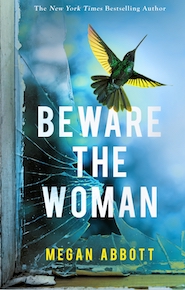
Every writer has a bag of tricks to conjure the muse. Scouring the newspaper, taking long drives, sipping a glass of scotch or two. For me, more often than not, it’s an image that sets my brain afire—a snapshot, a painting, a tabloid photo that summons a feeling or a mood that drives the story. Sometimes, the connection is obvious. A blurry photo of a shoe tread on a cheerleader’s shoulder inspired Dare Me, my novel about a murder within a brutally competitive cheer squad. But for my latest novel, Beware the Woman, the image that started me off has no obvious connection to the book that sprung from it, and teasing out the relationship between the two is far more delicate an operation.
The image is really a still, a screenshot from the final moments of the original slasher, Tobe Hooper’s The Texas Chainsaw Massacre (1974). If you’ve seen the movie, you may immediately think of the unforgettable sight of the killer, Leatherface improbably dancing on an arid road, swinging his chainsaw above his head. But it’s the moment right before that interests me: the actress Marilyn Burns, playing Sally Hardesty, has narrowly escaped Leatherface and leapt onto the back of a flatbed truck. As the truck drives away, we watch as Sally, her face painted with blood, looks back at the receding killer with a terror and a relief so piercing that she begins laughing hysterically, agonizingly. It’s haunting. It sears itself on your brain.
Sally Hardesty is an iconic figure in the genre as one of the original “final girls,” as famously termed by film critic in her book, Carole Clover’s Men, Women & Chainsaws: Gender in the Modern Horror Film. In Clover’s framing, the final girl (see also Laurie in Halloween) makes it to the end of the movie’s bloodbath by proving to have more “courage or levelheadedness” than anyone else, foremost her “cringing male counterparts.” She is “chased, cornered, wounded” long after her friends have all lost their lives. The final girl alone “looks death in the face” and finds the strength to survive.
In Beware the Woman, the protagonist, Jacy, faces no slasher massacre. Not a literal one, at least. But she has unwittingly entered a space that comes to feel dangerous. Newly married and newly pregnant she has traveled with her husband, Jed, for a visit to the lush, remote Upper Peninsula of Michigan to spend time with Jed’s charismatic father, Doctor Ash. After a mild health scare, her pregnancy becomes a source of growing concern for the men and Jacy begins to realize how little she really knows about Jed’s complicated relationship with his father and the role it may play in their marriage.
For reasons I couldn’t articulate while working on the book, that image of Sally, bloody and hysterical and resilient, felt like the final image I was writing toward. An image of resilience and resistance but a complicated one. Sally has survived, but barely. And what she’s experienced—well, it’s not over, not really.
But it’s only now that the novel’s finished and out in the world that I’ve come to see the larger connections to Texas Chainsaw Massacre. The Tobe Hooper film tells the story of five young people, including Sally, driving deep into unfamiliar territory to visit the grave of Sally’s grandfather. On the way, they come upon a ramshackle, sinister house and, eventually, the mysterious family inside. There is a fairy tale quality to the story—Hansel and Gretel come to life—that also rings through my own book. As does the notion of a stranger in a stranger land. Like Jacy, Sally and her friends stumble into a place and a people they do not understand and end up victims of a family of men with a history too troubling to ponder. In the movie’s famous setpiece, Sally, made captive, is forced to dine with Leatherface, his brother, his father and his grandfather, along with the mummified corpse of their grandmother. It’s a ghoulish simulacrum of a family dinner, with a demented patriarch at the head of the table. But somehow Sally escapes.
Slashers, like thrillers and mysteries—perhaps like all genre tales—tend to be diminished, even now, as escapist or exploitation fare. Of formula and sensationalism. But ultimately what Texas Chainsaw Massacre reveals is how deeply these stories speak to the culture and to the specific anxieties of their moment—in that case, springing from the disillusionment of the Baby Boomers, coming off a decade of Vietnam, assassinations, turmoil. A generation distrustful of their parents, authority, government and even the nation’s history itself. “I was reacting to life around me, as I knew it,” Hooper said. And you can feel it in every frame.
While I didn’t set out to write a novel about a throbbing cultural or political anxiety, one did sneak up on me. I’ve often written about the way female bodies are displayed, projected upon, medicalized, pathologized. These dynamics are all set in high relief in the case of a pregnant woman, like Jacy, who under such an intense gaze of institutionalized medicine, societal expectations and the scolding judgement of others. But I had no idea that, a few months after the book was completed, the U.S. Supreme Court would overturn Roe vs. Wade. Looking back, however, those fears had been rippling me and most of the women I know for the past several years.
So now, looking at that indelible image of Sally now, I’m doubly struck by its resonance. Terrorized and imprisoned by a family of men who seek to (in this case, literally) consume her, she has found her strength and power. She’s escaped, but we haven’t. She’s escaped, but even she—staring out at Leatherface, spinning around like a deranged ballerina, that chainsaw tearing through the air—doesn’t seem sure for how long.
 Hardback £18.99Little, Brown Book Group
Hardback £18.99Little, Brown Book Group
Published: 06 July, 2023
Photo © Nina Subin